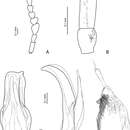Description
provided by Zookeys
Size and shape: Beetle middle-sized (TL-H 4.5–4.8 mm, TL 4.95–5.3 mm, MW 2.35–2.55 mm), with oblong-oval habitus, broadest at elytral middle. Coloration: Dorsally uniformly dark brown or head and pronotum slightly paler, with paler (yellowish-red to reddish-brown) anterior margin of head, lateral sides of pronotum, and narrow bands along elytral suture; head appendages yellowish-red to reddish-brown, legs slightly darker (Fig. 33).
Surface sculpture: Head with dense punctation (spaces between punctures 1–3 times size of punctures), evidently finer and sparser anteriorly; diameter of punctures smaller than diameter of cells of microreticulation. Pronotum with finer, sparser, and more evenly distributed punctation than on head. Elytra with very sparse and fine punctation, almost invisible. Head, pronotum, and elytra with weakly impressed microreticulation, dorsal surface, thus, shiny. Head with microreticulation stronger. Metaventrite and metacoxa distinctly microreticulate, metacoxal plates with longitudinal strioles and transverse wrinkles. Abdominal sternites with distinct microreticulation, strioles, and fine sparse punctation, coarser and denser on two last abdominal sternites.
Structures: Pronotum with distinct lateral bead. Base of prosternum and neck of prosternal process with strong, sharp ridge, without anterolateral extensions. Blade of prosternal process lanceolate, narrow, convex, with distinct bead and few setae; neck and blade of prosternal process evenly jointed. Abdominal sternite 7 broadly rounded apically.
Male: Antennomere 3 strongly enlarged, evidently larger than other, antennomere 4 distinctly enlarged (Fig. 7A); antennomeres 3 and 4 rugose ventrally. Protarsomere 4 with very small (smaller than more laterally situated large seta), thin, slightly curved anterolateral hook. Protarsomere 5 ventrally with anterior row (double apically) of 19 short setae and posterior row of 6 short setae (Fig. 7B). Abdominal sternite 7 with 6–11 lateral striae on each side. Median lobe with very weak submedian constriction in ventral view, apex of median lobe almost rounded in lateral view (Figs 7C, D). Paramere distinctly longer than median lobe, without notch on dorsal side, with relatively short, sparse, thin setae (Fig. 7E).
Female: Antennae simple, abdominal sternite 7 without striae.
- license
- cc-by-3.0
- copyright
- Helena V. Shaverdo, Suriani Surbakti, Lars Hendrich, Michael Balke
- bibliographic citation
- Shaverdo H, Surbakti S, Hendrich L, Balke M (2012) Introduction of the Exocelina ekari-group with descriptions of 22 new species from New Guinea (Coleoptera, Dytiscidae, Copelatinae) ZooKeys 250: 1–76
- author
- Helena V. Shaverdo
- author
- Suriani Surbakti
- author
- Lars Hendrich
- author
- Michael Balke
Distribution
provided by Zookeys
Papua New Guinea. This species is known from Eastern Highlands Province (Fig. 50).
- license
- cc-by-3.0
- copyright
- Helena V. Shaverdo, Suriani Surbakti, Lars Hendrich, Michael Balke
- bibliographic citation
- Shaverdo H, Surbakti S, Hendrich L, Balke M (2012) Introduction of the Exocelina ekari-group with descriptions of 22 new species from New Guinea (Coleoptera, Dytiscidae, Copelatinae) ZooKeys 250: 1–76
- author
- Helena V. Shaverdo
- author
- Suriani Surbakti
- author
- Lars Hendrich
- author
- Michael Balke

